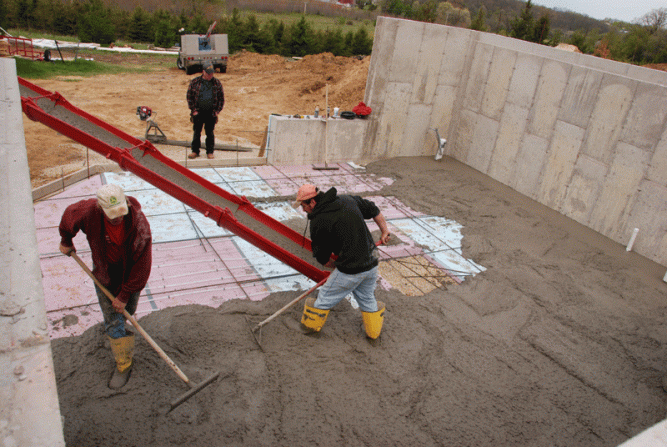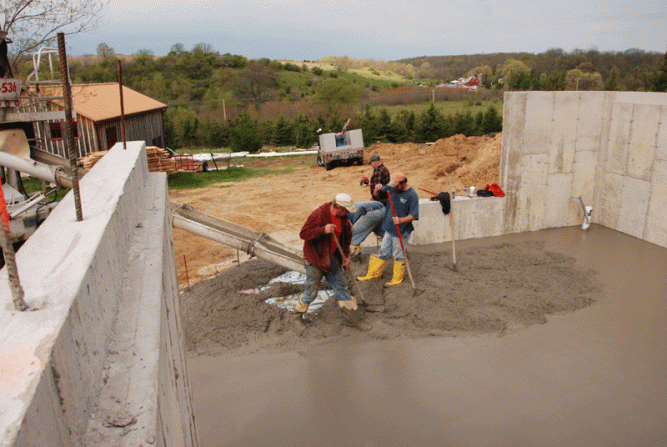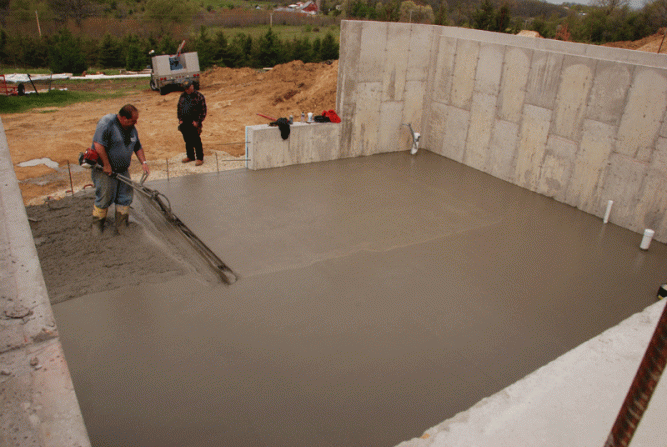My last post showed how our PEX tubing was installed. That happened on Monday. On Tuesday Mike Flynn arrived with his crew to bury it in 4 inches of reinforced concrete and create our basement floor.
 Doug wanted me to get one more photo of the bracket that held all the PEX tubing in place below the manifold, and I thought I was in plenty of time, but as I came to County Highway H, the concrete truck sailed past me and I had to follow it up our driveway. By the time I got my camera out and ran to the house site, the concrete shoot was already in place and ready to pour. But they held up long enough for me to tip toe across the Styrofoam, being careful not to step on any PEX tubing, get my shot, and hotfoot it back out of the way. Then the shoot began to vibrate and a deep, gravelly rumble filled the air. The concrete was flowing!
Doug wanted me to get one more photo of the bracket that held all the PEX tubing in place below the manifold, and I thought I was in plenty of time, but as I came to County Highway H, the concrete truck sailed past me and I had to follow it up our driveway. By the time I got my camera out and ran to the house site, the concrete shoot was already in place and ready to pour. But they held up long enough for me to tip toe across the Styrofoam, being careful not to step on any PEX tubing, get my shot, and hotfoot it back out of the way. Then the shoot began to vibrate and a deep, gravelly rumble filled the air. The concrete was flowing!
 I watched as Mike and his crew moved calmly and deliberately, wading through the concrete slush and spreading it out. They had marked a red line all around the wall as a guide, and they had placed several rods in the middle of the floor, laser-leveled to the same height.
I watched as Mike and his crew moved calmly and deliberately, wading through the concrete slush and spreading it out. They had marked a red line all around the wall as a guide, and they had placed several rods in the middle of the floor, laser-leveled to the same height.
 Mike operated a power trowel that was about 8 feet wide. It had a motor on it that made it vibrate. Behind the power trowel, the lumpy slush was transformed into an almost glassy smooth surface.
Mike operated a power trowel that was about 8 feet wide. It had a motor on it that made it vibrate. Behind the power trowel, the lumpy slush was transformed into an almost glassy smooth surface.
 The ground around the house is pretty spongy because it’s covered with freshly-excavated dirt from digging the basement, so Mike had the concrete delivered in two half-full trucks. That ensured that neither truck would get stuck somewhere just out of reach of the far corners of the basement. The second truck pulled up as the first was emptying.
The ground around the house is pretty spongy because it’s covered with freshly-excavated dirt from digging the basement, so Mike had the concrete delivered in two half-full trucks. That ensured that neither truck would get stuck somewhere just out of reach of the far corners of the basement. The second truck pulled up as the first was emptying.
 I was a little dismayed to see the crew walking around on top of the PEX tubing, but Andy, the Full Spectrum engineer who had carefully laid out and stapled down the tubing the day before, had told me it was strong enough to be stepped on. And they really didn’t have a choice. There is a lot of manipulation to get a concrete floor smoothed out.
I was a little dismayed to see the crew walking around on top of the PEX tubing, but Andy, the Full Spectrum engineer who had carefully laid out and stapled down the tubing the day before, had told me it was strong enough to be stepped on. And they really didn’t have a choice. There is a lot of manipulation to get a concrete floor smoothed out.
 Once again, Mike estimated the amount of concrete very accurately and there was only a little concrete left over when the floor was full.
Once again, Mike estimated the amount of concrete very accurately and there was only a little concrete left over when the floor was full.
Within a few hours, the concrete was hard enough to walk on, and they spent a few more hours moving around with a big device that looked like a giant buffing machine. It had paddles, which they gradually raised, and each pass brought more of the finest particles to the surface in a process known as creaming, to make it smoother and smoother.
It will continue to cure for years, but will be hard enough to work on in days.
 Speaking of how the concrete is hardening, Prairie and Brad nailed Styrofoam panels on the outside of the east basement wall today. They had put Styrofoam on the other walls about a week ago. They both commented that it was much harder to drive the nails into the concrete this week. Though it looks exactly the same, it is getting more rock-like every day.
Speaking of how the concrete is hardening, Prairie and Brad nailed Styrofoam panels on the outside of the east basement wall today. They had put Styrofoam on the other walls about a week ago. They both commented that it was much harder to drive the nails into the concrete this week. Though it looks exactly the same, it is getting more rock-like every day.
Last night, Doug and I entertained our first guest in our new “home” when my best friend Susan Krause dropped by. We grabbed some of the white plastic lawn chairs I have been rescuing from Madison curbsides , opened three bottles of local beer and had a good gab on the new slab.
It felt like home.
Categories: Eco architecture, TALES FROM OUR 44 ACRES
Love it! A Good Gab on the New Slab – I believe there’s a book title in there somewhere. 🙂
I hope so, Lorijo. I hope so.
Great article! I was wondering about them stepping on the tubing also, while pouring out the concrete. Amazing!
Yes, there was a pressure gauge in full view through the whole process, and the tubes maintained their pressure, so it looks like they were encased in concrete in an intact state. Yay.